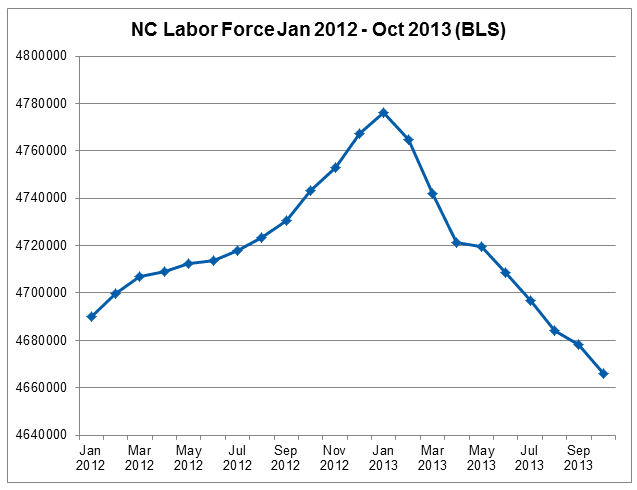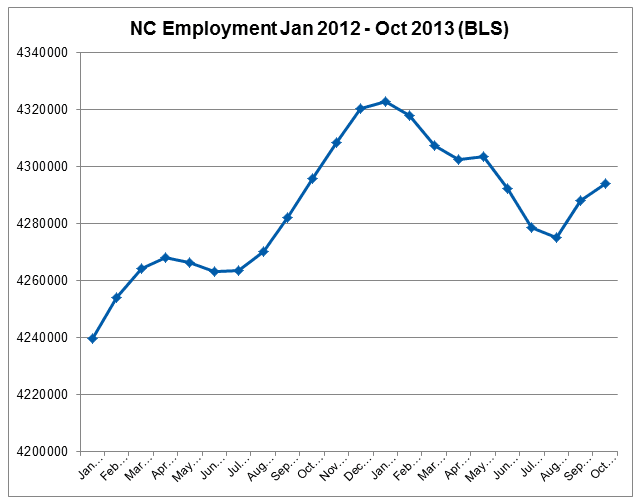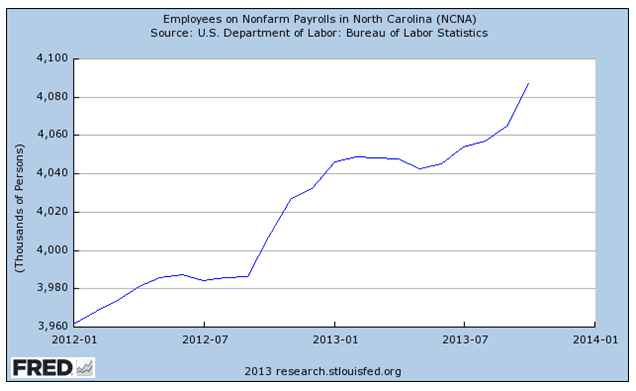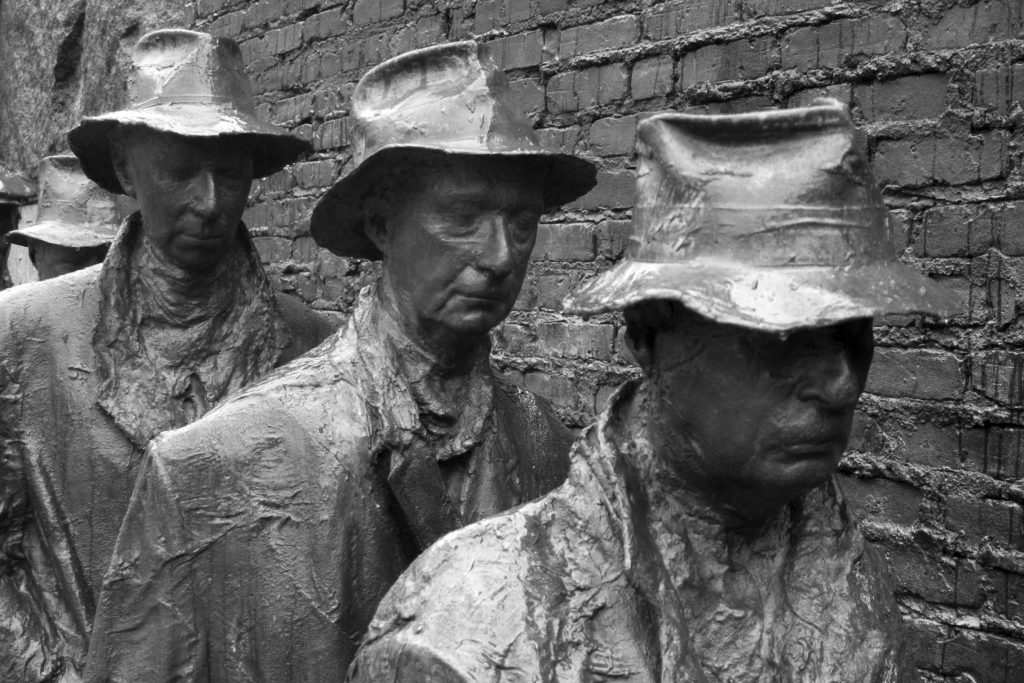As the political and policy debate over federal unemployment benefits rages in Washington, my home state of North Carolina has become a focal point. This is because the NC legislature’s decision to cut the level and duration of unemployment benefits, effective July 1, 2013, also ended at that time the state’s eligibility for the federal Emergency Unemployment Compensation program, which is scheduled to end nationwide on December 31, 2013. Thus, many pundits and aspiring Thought Leaders have argued that North Carolina’s employment experience since July provides a “natural experiment” of sorts as to what we might expect to happen nationally in 2014 when the EUC program ends.
Partisans on both sides of the aisle have already declared the North Carolina experiment to be a huge success or total failure which, of course, confirms their preexisting economic ideologies, and they’ve done so even though the experiment has obvious limitations that would keep any serious policy wonk from drawing broad and definitive conclusions: state markets can differ greatly from each other and from the national market; it’s difficult – if not impossible – to isolate the impact of a single policy change on something as diverse and dynamic as a multi-million person labor market; and we only have a few months of post-July employment data to examine (federal employment data are only through October). But while the NC experiment really isn’t an ideal predictor of the 2014 US labor market (at least not yet), it has already proven useful in one regard: shining a bright light on certain policy commentators’ own economic blind spots and the powerful siren song of confirmation bias.
A fine example of such a phenomenon comes from Bloomberg’s Evan Soltas who writes (in the subtlety-titled “North Carolina Shows How to Crush the Unemployed”) that what’s happening in here is “troubling” due to observed declines in the number of North Carolinians receiving or filing for benefits and a decline in the state’s labor force participation:
As intended, presumably, the number of North Carolinians receiving unemployment benefits has collapsed. It’s down by 45,000, or 40 percent, since last year. Expiring benefits aren’t the only reason for this. Far fewer are filing a claim in the first place. Initial claims are running at about half last year’s rate. Unemployment insurance is a thinner safety net than it has been in decades.
Soltas then cites some anecdotal evidence (based on Raleigh-area news article) that private food banks in North Carolina have been overwhelmed, supposedly, because of the unemployment benefit cuts. Based on these stories and the aforementioned data, he draws an ominous (and kinda preachy, honestly) conclusion about the future of the US labor market:
Some 1.3 million Americans will lose unemployment benefits immediately in 2014, according to a report from National Employment Law Project. An additional 850,000 will lose them by the end of March. North Carolina just ran this policy experiment. Does Washington like what it sees?
All of this sounds just horrible, so I decided to check the BLS data for myself to see if the employment picture really is as bad in my home state as Soltas claims and whether the data really do unequivocally – or at least enough to settle any silly “partisan debate” – prove that North Carolina’s unemployment experiment has “caused” the problems he and others allege. (AEI’s Jim Pethokoukis, for example, quickly concurred with Soltas’ conclusions, as did NRO’s Reihan Salam albeit more cautiously.)
Fortunately for me and my fellow North Carolinians, the answer to both questions is an unequivocal “no.”
In fact, I think it’s pretty safe to say that no reasonable policy wonk – or person who understands basic statistics – would look at the entire set of BLS data and come to such a conclusion. First, while Soltas is correct that North Carolina has experienced a dramatic decline in labor force participation since October 2012, the BLS data show that the majority of this drop occurred before the cut to unemployment benefits took effect in July:

As you can see, labor force participation peaked in January 2013 and then plummeted in the subsequent months (thus contributing to the state’s declining unemployment rate and falling levels of unemployed). Yes, participation continued to drop after the July benefit cut, but the data make clear that this was simply a continuation of the trend, not the result of some serious economic gamechanger over the summer. Indeed, it appears that the rate of decline actually decelerated a bit over 2013, with more people dropping out in the four month January – April period (54,835) than in the subsequent five month May – October period (53,717). Thus, it’s simply impossible to state with any degree of certainty that the elimination of federal unemployment benefits in July caused some mass exodus of discouraged workers from North Carolina’s labor market.
Unfortunately for Soltas, it gets worse: he completely ignores the interesting – and so far encouraging – data on rising total employment in the state over the last couple months:

This chart and the underlying data show that the number of employed persons in North Carolina began falling in January 2013, bottomed out in August, then rebounded significantly in September and again in October. In fact, the state gained 19,053 jobs between the August nadir and October (the latest month for which we have data). As already noted, this is a limited dataset and thus insufficient to draw any strong conclusions, but one could look at these initial numbers and reasonably surmise that, after a short transition period of fading benefits and more aggressive job-searching in July, North Carolinians actually began landing jobs August, then more rapidly acquired them in September and October.
But wait, there’s more: the BLS’ non-farm payroll data for 2012-2013 paint an even better picture for the state: 
Here, we have payrolls declining a bit in early 2013, beginning to rise over the summer, and then taking off in the fall – again consistent with the story above. In fact, between June and October, the state gained 41,600 non-farm jobs according to this BLS payroll data – 30,100 of which in September and October alone.
In other words, these data could very well indicate that the “heartless” elimination of unemployment benefits did precisely what many on the right predicted that it would (and precisely the opposite of what Soltas concluded): push the unemployed to seek out, and eventually take, less-than-ideal jobs, thereby boosting total employment (not to mention easing the burden on state coffers, enhancing labor market dynamism and increasing economic growth).
This trend might also explain why, as Soltas notes, initial jobless claims are down: people are actually finding and taking jobs again! More data are certainly needed here, but the initial returns appear positive and most definitely do not indicate abject despair in the Tarheel State.
Given that the remainder of Soltas’ piece cites anecdotal evidence to prove the benefit cuts’ pernicious effects on North Carolinians, he’s left without any empirical data to support his unequivocal, mic-dropping conclusion that such cuts undeniably caused serious problems in the state’s labor market. In fact, not only is there no causation here, but you can’t even legitimately say there’s a strong correlation between the cuts and any observed employment concerns. Maybe this correlation will appear in the coming months, but, right now, the data just aren’t there and instead point to the exact opposite conclusion. (However, unlike some people, I would never use a few months of data to draw such sweeping generalizations about unemployment assistance and labor economics.)
Beyond the data, even Soltas’ own anecdotal evidence (assuming you can get past the headline and, you know, actually read the article he linked) undermines his steadfast conclusions. First, like the decline in labor force participation, private food charities like the Interfaith Food Shuttle first saw a spike in demand before the unemployment benefit cuts took place in July. Second, the article shows that several factors – including cuts to and problems with state and federal food stamp programs – are blamed for the observed run on NC food banks, not just cuts to jobless benefits. If you don’t believe me, read the article for yourself.
Put simply: far from obviously settling the debate about unemployment benefits, Soltas’ piece does nothing of the sort and actually appears to be a pretty big wonkery fail – one that totally distorts what’s actually going on in North Carolina and its implications for the nation as a whole.
That said, he certainly wasn’t the only one to look at isolated snippets of the NC labor market data and boldly conclude that the termination of unemployment benefits hurt the state’s unemployed – as mentioned above AEI’s Jim Pethokoukis and NRO’s Reihan Salam cautiously came to similar conclusions (and were, it appears, equally wrong to do so). And these are not dumb guys (or political hacks), so I doubt this is simply due to an inability to understand the difference between causation and correlation or to properly research basic BLS data. Instead, it appears to be a classic case of confirmation bias: they wanted to draw these conclusions and thus focused on the few, distorted datapoints that confirmed their preexisting views.
In Soltas’ case, his emotional finger-wagging quite clearly indicates that this is more than just an cold, empirical experiment for him (I’ll leave it to you to guess why); Pethokoukis has been assailing cuts to federal jobless benefits for weeks now; and Salam admits in his short piece that he supports extending (and reforming) them. So, I’d guess, they seized on the state labor force data without actually looking at the longer-term trends or other important data like the latest employment figures.
If I’m right, Soltas, Pethokoukis and Salam never intended to mislead their readers, but, in their rush to prove a strongly-held view, they ended up doing it anyway. That’s better, I guess, but it’s still not good for people who are supposedly above the partisan fray and committed to the truth, rather than personal or ideological point-scoring. At least in the case of Pethokoukis and Salam, they’re quite transparent about their biases.
The views expressed herein are Scott Lincicome’s alone and do not necessarily represent the views of his employer, White & Case, LLP.



